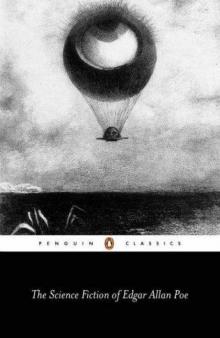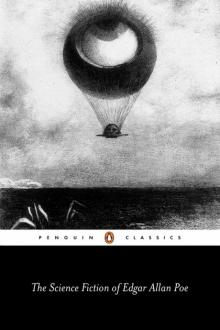- Home
- Edgar Allan Poe
The Science Fiction of Edgar Allan Poe (Penguin Classics) Page 34
The Science Fiction of Edgar Allan Poe (Penguin Classics) Read online
Page 34
At this point, however, it seems proper to suggest that, in fact, we have been speaking of comparative trifles. Our Sun – the central and controlling orb of the system to which Jupiter belongs, is not only greater than Jupiter, but greater by far than all the planets of the system taken together. This fact is an essential condition, indeed, of the stability of the system itself. The diameter of Jupiter has been mentioned: – it is 86,000 miles : – that of the Sun is 882,000 miles. An inhabitant of the latter, travelling 90 miles a day, would be more than 80 years in going round its circumference. It occupies a cubical space of 681 quadrillions, 472 trillions of miles. The Moon, as has been stated, revolves about the Earth at a distance of 237,000 miles – in an orbit, consequently, of nearly a million and a half. Now, were the Sun placed upon the Earth, centre over centre, the body of the former would extend, in every direction, not only to the line of the Moon’s orbit, but beyond it, a distance of 200,000 miles.
And here, once again, let me suggest that, in fact, we have still been speaking of comparative trifles. The distance of the planet Neptune from the Sun has been stated: – it is 28 hundred millions of miles; its orbit, therefore, is about 17 billions. Let this be borne in mind while we glance at some one of the brightest stars. Between this and the star of our system, (the Sun,) there is a gulf of space, to convey any idea of which we should need the tongue of an archangel. From our system, then, and from our Sun, or star, the star at which we suppose ourselves glancing is a thing altogether apart: – still, for the moment, let us imagine it placed upon our Sun, centre over centre, as we just now imagined this Sun itself placed upon the Earth. Let us now conceive the particular star we have in mind, extending, in every direction, beyond the orbit of Mercury – of Venus – of the Earth: – still on, beyond the orbit of Mars – of the asteroids – of Jupiter – of Saturn – of Uranus – until, finally, we fancy it filling the circle – 17 billions of miles in circumference – which is described by the revolution of Leverrier’s planet. When we have conceived all this, we shall have entertained no extravagant conception. There is the very best reason for believing that many of the stars are even far larger than the one we have imagined. I mean to say that we have the very best empirical basis for such belief: – and, in looking back at the original, atomic arrangements for diversity, which have been assumed as a part of the Divine plan in the constitution of the Universe, we shall be enabled easily to understand, and to credit, the existence of even far vaster disproportions in stellar size than any to which I have hitherto alluded. The largest orbs, of course, we must expect to find rolling through the widest vacancies of Space.
I remarked, just now, that to convey an idea of the interval between our Sun and any one of the other stars, we should require the eloquence of an archangel. In so saying, I should not be accused of exaggeration; for, in simple truth, these are topics on which it is scarcely possible to exaggerate. But let us bring the matter more distinctly before the eye of the mind.
In the first place, we may get a general, relative conception of the interval referred to, by comparing it with the inter-planetary spaces. If, for example, we suppose the Earth, which is, in reality, 95 millions of miles from the Sun, to be only one foot from that luminary; then Neptune would be 40 feet distant; and the star Alpha Lyrœ, at the very least, 159.
Now I presume that, in the termination of my last sentence, few of my readers have noticed anything especially objectionable – particularly wrong. I said that the distance of the Earth from the Sun being taken at one foot, the distance of Neptune would be 40 feet, and that of Alpha Lyræ, 159. The proportion between one foot and 159, has appeared, perhaps, to convey a sufficiently definite impression of the proportion between the two intervals – that of the Earth from the Sun and that of Alpha Lyræ from the same luminary. But my account of the matter should, in reality, have run thus : – The distance of the Earth from the Sun being taken at one foot, the distance of Neptune would be 40 feet, and that of Alpha Lyrae, 159 — miles : – that is to say, I had assigned to Alpha Lyræ, in my first statement of the case, only the 5280th part of that distance which is the least distance possible at which it can actually lie.
To proceed: – However distant a mere planet is, yet when we look at it through a telescope, we see it under a certain form – of a certain appreciable size. Now I have already hinted at the probable bulk of many of the stars; nevertheless, when we view any one of them, even through the most powerful telescope, it is found to present us with no form, and consequently with no magnitude whatever. We see it as a point and nothing more.
Again; – Let us suppose ourselves walking, at night, on a highway. In a field on one side of the road, is a line of tall objects, say trees, the figures of which are distinctly defined against the background of the sky. This line of objects extends at right angles to the road, and from the road to the horizon. Now, as we proceed along the road, we see these objects changing their positions, respectively, in relation to a certain fixed point in that portion of the firmament which forms the background of the view. Let us suppose this fixed point – sufficiently fixed for our purpose – to be the rising moon. We become aware, at once, that while the tree nearest us so far alters its position in respect to the moon, as to seem flying behind us, the tree in the extreme distance has scarcely changed at all its relative position with the satellite. We then go on to perceive that the farther the objects are from us, the less they alter their positions; and the converse. Then we begin, unwittingly, to estimate the distances of individual trees by the degrees in which they evince the relative alteration. Finally, we come to understand how it might be possible to ascertain the actual distance of any given tree in the line, by using the amount of relative alteration as a basis in a simple geometrical problem. Now this relative alteration is what we call ‘parallax’; and by parallax we calculate the distances of the heavenly bodies. Applying the principle to the trees in question, we should, of course, be very much at a loss to comprehend the distance of that tree, which, however far we proceeded along the road, should evince no parallax at all. This, in the case described, is a thing impossible; but impossible only because all distances on our Earth are trivial indeed : – in comparison with the vast cosmical quantities, we may speak of them as absolutely nothing.
Now, let us suppose the star Alpha Lyræ directly overhead; and let us imagine that, instead of standing on the Earth, we stand at one end of a straight road stretching through Space to a distance equalling the diameter of the Earth’s orbit – that is to say, to a distance of 190 millions of miles. Having observed, by means of the most delicate micrometrical instruments, the exact position of the star, let us now pass along this inconceivable road, until we reach its other extremity. Now, once again, let us look at the star. It is precisely where we left it. Our instruments, however delicate, assure us that its relative position is absolutely – is identically the same as at the commencement of our unutterable journey. No parallax – none whatever – has been found.
The fact is, that, in regard to the distance of the fixed stars – of any one of the myriads of suns glistening on the farther side of that awful chasm which separates our system from its brothers in the cluster to which it belongs – astronomical science, until very lately, could speak only with a negative certainty. Assuming the brightest as the nearest, we could say, even of them, only that there is a certain incomprehensible distance on the hither side of which they cannot be : – how far they are beyond it we had in no case been able to ascertain. We perceived, for example, that Alpha Lyræ cannot be nearer to us than 19 trillions, 200 billions of miles; but, for all we knew, and indeed for all we now know, it may be distant from us the square, or the cube, or any other power of the number mentioned. By dint, however, of wonderfully minute and cautious observations, continued, with novel instruments, for many laborious years, Bessel, not long ago deceased,45 has lately succeeded in determining the distance of six or seven stars; among others, that of the star numbered 61 in the constellation of the Sw
an. The distance in this latter instance ascertained, is 670,000 times that of the Sun; which last it will be remembered, is 95 millions of miles. The star 61 Cygni, then, is nearly 64 trillions of miles from us – or more than three times the distance assigned, as the least possible, for Alpha Lyræ.
In attempting to appreciate this interval by the aid of any considerations of velocity, as we did in endeavoring to estimate the distance of the moon, we must leave out of sight, altogether, such nothings as the speed of a cannon ball, or of sound. Light, however, according to the latest calculations of Struve, proceeds at the rate of 167,000 miles in a second. Thought itself cannot pass through this interval more speedily – if, indeed, thought can traverse it at all. Yet, in coming from 61 Cygni to us, even at this inconceivable rate, light occupies more than ten years; and, consequently, were the star this moment blotted out from the Universe, still, for ten years, would it continue to sparkle on, undimmed in its paradoxical glory.
Keeping now in mind whatever feeble conception we may have attained of the interval between our Sun and 61 Cygni, let us remember that this interval, however unutterably vast, we are permitted to consider as but the average interval among the countless host of stars composing that cluster, or ‘nebula’, to which our system, as well as that of 61 Cygni, belongs. I have, in fact, stated the case with great moderation: – we have excellent reason for believing 61 Cygni to be one of the nearest stars, and thus for concluding, at least for the present, that its distance from us is less than the average distance between star and star in the magnificent cluster of the Milky Way.
And here, once again and finally, it seems proper to suggest that even as yet we have been speaking of trifles. Ceasing to wonder at the space between star and star in our own or in any particular cluster, let us rather turn our thoughts to the intervals between cluster and cluster, in the all comprehensive cluster of the Universe.
I have already said that light proceeds at the rate of 167,000 miles in a second – that is, about 10 millions of miles in a minute, or about 600 millions of miles in an hour: – yet so far removed from us are some of the ‘nebulæ’ that even light, speeding with this velocity, could not and does not reach us, from those mysterious regions, in less than 3 millions of years. This calculation, moreover, is made by the elder Herschel, and in reference merely to those comparatively proximate clusters within the scope of his own telescope.46 There are ‘nebulæ’, however, which, through the magical tube of Lord Rosse, are this instant whispering in our ears the secrets of a million of ages by-gone. In a word, the events which we behold now – at this moment – in those worlds – are the identical events which interested their inhabitants ten hundred thousand centuries ago. In intervals – in distances such as this suggestion forces upon the soul – rather than upon the mind – we find, at length, a fitting climax to all hitherto frivolous considerations of quantity.
Our fancies thus occupied with the cosmical distances, let us take the opportunity of referring to the difficulty which we have so often experienced, while pursuing the beaten path of astronomical reflection, in accounting for the immeasurable voids alluded to – in comprehending why chasms so totally unoccupied and therefore apparently so needless, have been made to intervene between star and star – between cluster and cluster – in understanding, to be brief, a sufficient reason for the Titanic scale, in respect of mere Space, on which the Universe of Stars is seen to be constructed. A rational cause for the phænomenon, I maintain that Astronomy has palpably failed to assign: – but the considerations through which, in this Essay, we have proceeded step by step, enable us clearly and immediately to perceive that Space and Duration are one. That the Universe of Stars might endure throughout an æra at all commensurate with the grandeur of its component material portions and with the high majesty of its spiritual purposes, it was necessary that the original atomic diffusion be made to so inconceivable an extent as to be only not infinite. It was required, in a word, that the stars should be gathered into visibility from invisible nebulosity – proceed from visibility to consolidation – and so grow grey in giving birth and death to unspeakably numerous and complex variations of vitalic development: – it was required that the stars should do all this – should have time thoroughly to accomplish all these Divine purposes – during the period in which all things were effecting their return into Unity with a velocity accumulating in the inverse proportion of the squares of the distances at which lay the inevitable End.
Throughout all this we have no difficulty in understanding the absolute accuracy of the Divine adaptation. The density of the stars, respectively, proceeds, of course, as their condensation diminishes; condensation and heterogeneity keep pace with each other; through the latter, which is the index of the former, we estimate the vitalic and spiritual development. Thus, in the density of the globes, we have the measure in which their purposes are fulfilled. As density proceeds – as the divine intentions are accomplished – as less and still less remains to be accomplished – so – in the same ratio – should we expect to find an acceleration of the End: – and thus the philosophical mind will easily comprehend that the Divine designs in constituting the stars, advance mathematically to their fulfilment: – and more; it will readily give the advance a mathematical expression; it will decide that this advance is inversely proportional with the squares of the distances of all created things from the starting-point and goal of their creation.
Not only is this Divine adaptation, however, mathematically accurate, but there is that about it which stamps it as divine, in distinction from that which is merely the work of human constructiveness. I allude to the complete mutuality of adaptation. For example; in human constructions a particular cause has a particular effect; a particular intention brings to pass a particular object; but this is all; we see no reciprocity. The effect does not re-act upon the cause; the intention does not change relations with the object. In Divine constructions the object is either design or object as we choose to regard it – and we may take at any time a cause for an effect, or the converse – so that we can never absolutely decide which is which.
To give an instance : – In polar climates the human frame, to maintain its animal heat, requires, for combustion in the capillary system, an abundant supply of highly azotized food, such as train oil. But again : – in polar climates nearly the sole food afforded man is the oil of abundant seals and whales. Now, whether is oil at hand because imperatively demanded, or the only thing demanded because the only thing to be obtained? It is impossible to decide. There is an absolute reciprocity of adaptation.
The pleasure which we derive from any display of human ingenuity is in the ratio of the approach to this species of reciprocity. In the construction of plot, for example, in fictitious literature,47 we should aim at so arranging the incidents that we shall not be able to determine, of any one of them, whether it depends from any one other or upholds it. In this sense, of course, perfection of plot is really, or practically, unattainable – but only because it is a finite intelligence that constructs. The plots of God are perfect. The Universe is a plot of God.
And now we have reached a point at which the intellect is forced, again, to struggle against its propensity for analogical inference – against its monomaniac grasping at the infinite. Moons have been seen revolving about planets; planets about stars; and the poetical instinct of humanity – its instinct of the symmetrical, even if the symmetry be but a symmetry of surface: – this instinct, which the Soul, not only of Man but of all created beings, took up, in the beginning, from the geometrical basis of the Universal radiation – impels us to the fancy of an endless extension of this system of cycles. Closing our eyes equally to deduction and induction, we insist upon imagining a revolution of all the orbs of the Galaxy about some gigantic globe which we take to be the central pivot of the whole. Each cluster in the great cluster of clusters is imagined, of course, to be similarly supplied and constructed; while, that the ‘analogy’ may be wanting at no point, we go on to concei
ve these clusters themselves, again, as revolving about some still more august sphere; – this latter, still again, with its encircling clusters, as but one of a yet more magnificent series of agglomerations, gyrating about yet another orb central to them – some orb still more unspeakably sublime – some orb, let us rather say, of infinite sublimity endlessly multiplied by the infinitely sublime. Such are the conditions, continued in perpetuity, which the voice of what some people term ‘analogy’ calls upon the Fancy to depict and the Reason to contemplate, if possible, without becoming dissatisfied with the picture. Such, in general, are the interminable gyrations beyond gyration which we have been instructed by Philosophy to comprehend and to account for – at least in the best manner we can. Now and then, however, a philosopher proper – one whose frenzy takes a very determinate turn – whose genius, to speak more reverentially, has a strongly-pronounced washer-womanish bias, doing every thing up by the dozen – enables us to see precisely that point out of sight, at which the revolutionary processes in question do, and of right ought to, come to an end.
It is hardly worth while, perhaps, even to sneer at the reveries of Fourier48 – but much has been said, latterly, of the hypothesis of Mädler49 – that there exists, in the centre of the Galaxy, a stupendous globe about which all the systems of the cluster revolve. The period of our own, indeed, has been stated – 117 millions of years.
That our Sun has a motion in space, independently of its rotation, and revolution about the system’s centre of gravity, has long been suspected. This motion, granting it to exist, would be manifested perspectively. The stars in that firmamental region which we were leaving behind us, would, in a very long series of years, become crowded; those in the opposite quarter, scattered. Now, by means of astronomical History, we ascertain, cloudily, that some such phænomena have occurred. On this ground it has been declared that our system is moving to a point in the heavens diametrically opposite the star Zeta Herculis : – but this inference is, perhaps, the maximum to which we have any logical right. Mädler, however, has gone so far as to designate a particular star, Alcyone in the Pleiades, as being at or about the very spot around which a general revolution is performed.

 The Works of Edgar Allan Poe — Volume 2
The Works of Edgar Allan Poe — Volume 2 The Works of Edgar Allan Poe — Volume 1
The Works of Edgar Allan Poe — Volume 1 The Works of Edgar Allan Poe — Volume 3
The Works of Edgar Allan Poe — Volume 3 The Works of Edgar Allan Poe — Volume 5
The Works of Edgar Allan Poe — Volume 5 The Works of Edgar Allan Poe — Volume 4
The Works of Edgar Allan Poe — Volume 4 The Tell-Tale Heart
The Tell-Tale Heart The Raven (Penguin)
The Raven (Penguin) The Paris Mysteries
The Paris Mysteries Tales of Terror from Edgar Allan Poe
Tales of Terror from Edgar Allan Poe The Fall of the House of Usher
The Fall of the House of Usher The Golden Book of World's Greatest Mysteries
The Golden Book of World's Greatest Mysteries The Narrative of Arthur Gordon Pym of Nantucket
The Narrative of Arthur Gordon Pym of Nantucket Ligeia
Ligeia The Landscape Garden
The Landscape Garden Complete Tales & Poems
Complete Tales & Poems Great Tales and Poems of Edgar Allan Poe
Great Tales and Poems of Edgar Allan Poe The Colloquy of Monos and Una
The Colloquy of Monos and Una The Oblong Box
The Oblong Box Thou Art the Man
Thou Art the Man A DESCENT INTO THE MAELSTROM
A DESCENT INTO THE MAELSTROM THE MURDERS IN THE RUE MORGUE
THE MURDERS IN THE RUE MORGUE The Business Man
The Business Man The Mystery of Marie Rogêt
The Mystery of Marie Rogêt Metzengerstein
Metzengerstein The Man That Was Used Up
The Man That Was Used Up William Wilson
William Wilson The Philosophy of Composition
The Philosophy of Composition The Portable Edgar Allan Poe
The Portable Edgar Allan Poe Bon-Bon
Bon-Bon A Predicament
A Predicament The Premature Burial
The Premature Burial The Angel of the Odd
The Angel of the Odd The Man of the Crowd
The Man of the Crowd Never Bet the Devil Your Head
Never Bet the Devil Your Head The Tell-Tale Heart and Other Writings
The Tell-Tale Heart and Other Writings The System of Doctor Tarr and Professor Fether
The System of Doctor Tarr and Professor Fether Selected Tales (Oxford World's Classics)
Selected Tales (Oxford World's Classics) Essential Tales and Poems of Edgar Allan Poe (Barnes & Noble Classics Series)
Essential Tales and Poems of Edgar Allan Poe (Barnes & Noble Classics Series) MS. Found in a Bottle
MS. Found in a Bottle Some Words with a Mummy
Some Words with a Mummy The Science Fiction of Edgar Allan Poe (Penguin Classics)
The Science Fiction of Edgar Allan Poe (Penguin Classics) King Pest
King Pest CRITICISM
CRITICISM How to Write a Blackwood Article
How to Write a Blackwood Article Mystification
Mystification Diddling Considered as One of the Exact Sciences
Diddling Considered as One of the Exact Sciences Steampunk Poe
Steampunk Poe The Literary Life of Thingum Bob, Esq.
The Literary Life of Thingum Bob, Esq. Classic Crime Collection
Classic Crime Collection Complete Stories and Poems of Edgar Allen Poe
Complete Stories and Poems of Edgar Allen Poe Berenice
Berenice The Black Cat
The Black Cat The Slender Poe Anthology
The Slender Poe Anthology The Science Fiction of Edgar Allan Poe
The Science Fiction of Edgar Allan Poe The Assignation
The Assignation The Thousand-and-Second Tale of Scheherazade
The Thousand-and-Second Tale of Scheherazade The Raven and Other Short Stories
The Raven and Other Short Stories The Spectacles
The Spectacles Hop-Frog
Hop-Frog The Purloined Letter
The Purloined Letter Mellonta Tauta
Mellonta Tauta The Balloon-Hoax
The Balloon-Hoax Landor's Cottage
Landor's Cottage Mesmeric Revelation
Mesmeric Revelation The Pit and the Pendulum
The Pit and the Pendulum